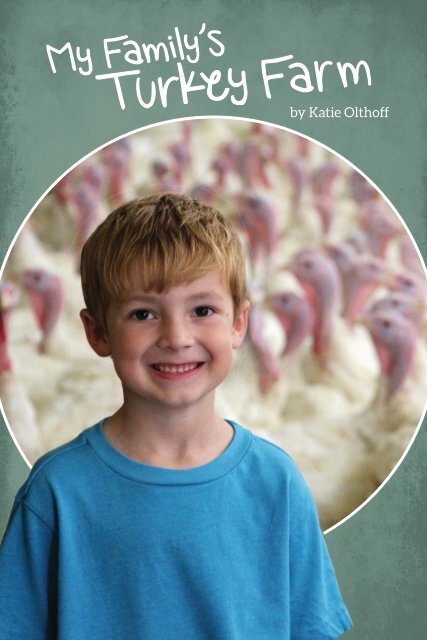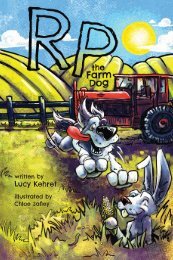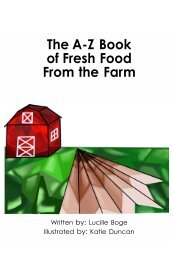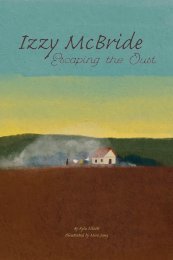My Family's Turkey Farm
Meet Adam, a 6-year-old farm boy from central Iowa. Adam and his family live on a large turkey farm and raise more than 100,000 turkeys every year. Learn how farmers take care of turkeys through Adam's eyes, as he takes you on a virtual tour of his turkey farm.
Meet Adam, a 6-year-old farm boy from central Iowa. Adam and his family live on a large turkey farm and raise more than 100,000 turkeys every year. Learn how farmers take care of turkeys through Adam's eyes, as he takes you on a virtual tour of his turkey farm.
You also want an ePaper? Increase the reach of your titles
YUMPU automatically turns print PDFs into web optimized ePapers that Google loves.
y Katie Olthoff
<strong>My</strong> Family’s <strong>Turkey</strong> <strong>Farm</strong><br />
Written by Katie Olthoff<br />
Designed by Jenn Hindman<br />
Printed as a special project of:<br />
Iowa Agriculture Literacy Foundation<br />
Iowa <strong>Turkey</strong> Federation<br />
Iowa Agriculture<br />
Literacy Foundation
2
<strong>My</strong> name is Adam. I am six years old<br />
and I am in Kindergarten. I love Legos,<br />
superheroes, and watermelon.<br />
I live with my brother, mom and dad on our<br />
turkey farm in Iowa.<br />
Adam is a real child, on a real turkey farm. His family raises turkeys in central<br />
Iowa. They live in the farmhouse where Bart, Adam’s dad, grew up. Bart<br />
and Katie, Adam’s mom, both graduated from Iowa State University before<br />
becoming farmers.<br />
3
<strong>My</strong> dad is a turkey farmer. Sometimes,<br />
my brother and I help him. We have fun<br />
working with him on the farm.<br />
The Olthoffs are third generation turkey farmers, and proud to raise their<br />
children on the farm.<br />
4
96% of farms in the United States are family farms.<br />
5
<strong>Turkey</strong>s are really neat animals. Our turkeys<br />
are cute and fluffy when they first come to<br />
our farm. Mom, Dad, Grandpa and I work<br />
together to unload them.<br />
The poults or baby turkeys hatch in Minnesota and come to the Olthoffs’ farm<br />
when they are one day old.<br />
That’s me!<br />
6
A group of turkeys is called a flock. The Olthoffs raise three flocks at a time.<br />
Each flock has 20,000 turkeys.<br />
7
After a couple of weeks, the turkeys grow<br />
white feathers. They have blue heads, and<br />
a red wattle under their beak and a red<br />
snood on top.<br />
Although wild turkeys have dark feathers, today’s farmers raise broadbreasted,<br />
white turkeys for two reasons. First, as the name suggests, this breed<br />
has a lot of breast meat, which consumers love. Second, dark feathers leave<br />
marks in the skin of a turkey, which consumers do not love.<br />
8
Snood<br />
Wattle<br />
9
When the turkeys get really big, I stay away<br />
from them. They weigh more than I do!<br />
Full grown toms (male turkeys) can weigh more than 45 pounds. Hens are a<br />
little smaller.<br />
<strong>Turkey</strong>s are actually living dinosaurs! They are closely related to Apatosaurus,<br />
Tyrannosaurus, and Velociraptor.<br />
10
Our turkeys live in barns like these. The<br />
barns keep them warm and dry.<br />
<strong>Turkey</strong> farmers want their birds to be comfortable. Today’s livestock barns are<br />
designed using scientific research to provide the best environment possible<br />
for the animals. <strong>Turkey</strong> barns protect the birds from predators, disease, and<br />
weather.<br />
11
12
<strong>My</strong> dad<br />
checks on the<br />
turkeys at<br />
least twice a<br />
day. He works<br />
every day,<br />
even holidays<br />
like the<br />
Fourth of July,<br />
Thanksgiving,<br />
and New<br />
Year’s Eve.<br />
<strong>Farm</strong>ers work with their livestock at least twice a day. They walk through the<br />
barns to make sure fans, feeders and drinkers are working properly. They look<br />
and listen to make sure the animals are healthy.<br />
<strong>Farm</strong>ing is not a 9 to 5 job. Bart works seven days a week and cannot go far<br />
from the farm, in case something goes wrong and needs to be fixed.<br />
13
<strong>Turkey</strong>s need food and water, just like we do.<br />
<strong>Turkey</strong>s eat corn and soybeans.<br />
<strong>Turkey</strong> feed is designed to give the birds the best nutrition possible. It consists<br />
mostly of corn and soybeans, but also contains other vitamins, nutrients, and<br />
protein. The feed formulation changes as the turkey gets bigger, meeting the<br />
bird’s nutritional needs as it grows.<br />
14
Automated feeders and drinkers give turkeys 24-hour access to clean, fresh<br />
food and water.<br />
In a turkey’s lifetime, they will consume about one bushel of corn and 1/3<br />
bushels of soybeans. A bushel is about the size of a small laundry basket.<br />
15
We try to keep our turkeys from getting<br />
sick. People wash their hands to get rid of<br />
germs. I wash my boots to make sure they<br />
are clean when I go in the barn.<br />
Disease prevention is a top priority. Housing turkeys in barns keeps them<br />
away from other birds that may carry disease. <strong>Farm</strong>ers also use biosecurity<br />
measures, such as wearing clean clothing and booths into barns, to keep germs<br />
away from the turkeys.<br />
16
17
18
But if<br />
turkeys do<br />
get sick, a<br />
veterinarian<br />
gives them<br />
medicine to<br />
make them<br />
better.<br />
<strong>Turkey</strong> health is very important to farmers. The turkeys are vaccinated, but<br />
sometimes they also need antibiotics. <strong>Farm</strong>ers work with veterinarians to<br />
decide when medicine is needed.<br />
19
When the turkeys are big, they leave<br />
our farm and go to a processing plant.<br />
It takes about 20 weeks to grow a turkey to market weight (about 45 pounds).<br />
The turkeys grow quickly because of excellent nutrition and breeding. There<br />
are no hormones or steroids used in poultry production in the United States.<br />
The turkeys are loaded on trucks and transported to the processing plant.<br />
20
21
We eat the<br />
meat from<br />
turkeys. I<br />
like turkey<br />
lunchmeat.<br />
Mom and Dad<br />
like turkey<br />
breast and<br />
ground turkey.<br />
Our whole<br />
family looks<br />
forward to<br />
Thanksgiving.<br />
The average American eats 18 pounds of turkey each year. Half of that is<br />
on sandwiches.<br />
22
<strong>My</strong> brother and I want to be turkey farmers<br />
when we grow up, just like our dad.<br />
23
24
Glossary<br />
ANTIBIOTIC: a medicine that helps an animal fight a disease or<br />
infection from a bacterium<br />
BARN: a building that keeps animals warm and safe<br />
BUSHEL: a measure of grain<br />
FARMER: someone who takes care of animals<br />
FLOCK: a group of turkeys<br />
HEN: a female turkey<br />
POULT: a baby turkey<br />
SNOOD: the red skin on top of a turkey’s beak<br />
TOM: a male turkey<br />
VACCINATED: a medicine that helps build an animal’s defense<br />
against disease and infections from bacteria<br />
VETERINARIAN: a doctor for animals<br />
WATTLE: the colored skin on the neck of the turkey<br />
25
Meet Adam, a 6-year-old farm boy from central Iowa.<br />
Adam and his family live on a large turkey farm and raise<br />
more than 100,000 turkeys every year.<br />
Learn how farmers take care of turkeys through Adam’s<br />
eyes, as he takes you on a virtual tour of his turkey farm.<br />
ADDITIONAL RESOURCES:<br />
www.iowaagliteracy.org

















